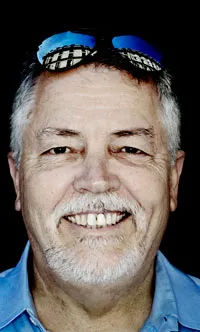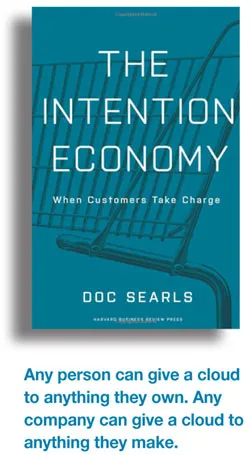Doc Searls sits at the intersection of business and technology. A coauthor of the bestselling Cluetrain Manifesto, he is a fellow at both the Berkman Center for Internet and Society at Harvard University and at the Center for Information Technology & Society at UC Santa Barbara. His latest book, The Intention Economy: When Customers Take Charge, predicts a near future where customers are in almost complete control of their relationships with companies, and even individual products. In this interview with Customer Strategist, he discusses the ramifications of such an environment on business, and what senior leaders can do to prepare for a truly customer-controlled world.

Customer Strategist: What is your opinion on the state of brands' relationships with their customers?
Doc Searls: Today too many companies are still trying to scale relationships with customers in the old industrial way—by minimizing actual human contact, scripting human interactions and treating customers in general as templates, rather than as the gods by whose grace every company exists. They also tend to think everything is up to the brand, rather than the customer.
This kind of thinking does not work well in a networked age when every entity (human and otherwise) is one click away from every other entity, and when any customer is in a position to make or break a company's reputation. The old defaulted value system of "scale at all costs" has even corrupted Customer Relationship Management (CRM). Rather than facilitating rich and genuine relationships between companies and customers, it is instead devoted almost entirely to pushing products through channels, minimizing actual customer engagement, and reducing customers to sources for analytic millwork.
Notable exceptions to this old-fashioned norm are Apple's and Trader Joe's retail operations, and Zappos' high-engagement approach to customer service—all of which harvest value from direct interactions with customers. But the defaults today are still industrial, and supported by giant B2B businesses devoted to "scale."
All opportunity for improvement is in the area Don Peppers and Martha Rogers outlined in The One to One Future, back in 1993. That future is finally starting to arrive, but it's still going to be a struggle.
CS: You're a proponent of Vendor Relationship Management, which fuels what you call the Intention Economy. Can you explain these concepts, and how they change a brand's relationship with customers?
DS: Vendor Relationship Management, or VRM, was conceived originally as the customer-side counterpart of CRM, which is now an $18 billion business, according to Gartner. The purpose of VRM is to give customers tools of their own for interacting with companies, to make customers better able to handle their ends of relationships with companies, and to make one-to-one concepts real by giving a customer one way to deal with many companies, rather than as many different ways to deal as there are companies, which is what CRM created.
The only way we can fix customer relationships is to give customers their own tools and services for integrating their own data, and interacting in standard and consistent ways with many different companies. For one-to-one relationships to truly work, the only silos should be the customers'.
Intent is a key concept here, because it's what each of us brings to the marketplace. Right now we still live in an "attention economy" in which traveling in the commercial Web requires standing under a Niagara Falls of messages, all of which compete for our attention and assume at every moment that we are ready to buy something. Most of the time we are not, which makes a huge percentage of that messaging wasteful.

But when we do have real intentions, that information is truly valuable, both to ourselves and to the goods-makers and sellers of the world. Google looks at the intentions we express through searches, but also makes inferences that are not ours. This is why Google gets it wrong much of the time. Once we are fully in charge of expressing our intentions as customers, an economy will arise out of the efficiencies we introduce.
Yes, there will always be gray areas where we don't quite know what we want, but even there we should possess far more agency than we do now. Things like VRM will provide that agency.
CS: How can brands be more psychic with customers to identify and act on customer intentions?
DS: I don't think brands need to be psychic at all. In fact I think trying to be psychic is a problem for them today. The cognitive overhead required to harvest and mill Big Data is immense, and expensive. What they need instead is to be human and connected. Peppers and Rogers wrote about this in The One to One Future in 1993, and many wrote about it afterwards, including the four authors of The Cluetrain Manifesto (including yours truly) in 1999. While being human at scale is almost impossible for a company to imagine, so were personal computing in 1973 and the Internet in 1988.
We'll make it happen, because we have to. All brands need to do is listen. It ain't hard. Today the channels carrying most of the talking are social—Twitter and Facebook. But there will also be other better channels in the future. And by "better" I mean less centrally controlled and advertising-driven.
CS: Do you think customers are ready to take more control of their relationship with the brands they do business with?
DS: They're about as ready for it as they were for personal computers in 1977, for the Internet in 1993, and for smartphones in 1999. By those examples I mean that it's getting close. They'll be ready when we get fully appealing inventions for controlling relationships.
CS: You've discussed the idea of using product clouds to evolve relationships with customers. This idea is starting to take hold as more actual items become connected as part of the "Internet of Things." In fact, ABI Research reports that there are more than 10 billion wirelessly connected devices in the market today, with more than 30 billion devices expected by 2020. Why is this important to the future of customer strategy?
DS: Everything in the Internet of Things (IoT) can have a cloud—a virtual place—of its own. This does not require that a thing have embedded intelligence, which is our usual assumption about the Internet of Things. All it needs is its own cloud, with its own operating system. One of these has already been invented, by Phil Windley and his crew at Kynetx. It's called CloudOS (for now), and it's open source. So is KRL, a language they wrote for programming logical connections between things and events.
So, when you own a thing, you can also own its cloud. In fact, you can have your thing and its cloud inside your own personal cloud (pcloud). What this means is that any person can give a cloud to anything they own. Any company can give a cloud to anything they make.
For example, Nikon can give every camera it sells its own cloud. It can provide access to the cloud through a unique QR code, just like it gives every camera its own serial number. Everybody in the supply chain can also look at that cloud through that code. So can the person who buys the camera, and the cloud along with it.
Let's say the camera's cloud comes with the instruction manual and a bunch of links to Nikon websites and services that will be useful for the camera's owner. The owner can keep all of that, and give Nikon permission to keep updating that information over time. The owner can also add data to the cloud, such as links to every photo put up on Flickr or Instagram. The owner can also communicate with Nikon through the camera's cloud, providing feedback, requesting help, or setting up logical connections.
I have a cable modem here with its own personal cloud, and its own QR code. I would like to program it to notify Time Warner Cable each time I scan it, and have Time Warner Cable text me if there is an outage in the area. I spoke about this scenario recently with two contact center companies. They loved it, and said it wouldn't be hard to implement on their side. And that's just one logical connection that can be programmed with KRL on CloudOS.
These examples uncork our imagination around how value can be codified, expressed, and paid for. All these kinds of things are on the table. And the table, remarkably, is the product itself.
This is new, and has many profound implications. The most important to me is that the owner of the product—the customer—is in a position of full control. He or she can now enjoy a true one-to-one relationship with parties on the supply side of that table. One party might be the maker of the product. Another might be the seller. Others might be in the supply chain, going back all the way to miners, farmers and factory workers. With clouds much more can be brought into equations than ever before.
CS: These are great ideas, but it's rare to see a company give up that much control. What's holding firms back from enabling an Intention Economy? Is it technological or ideological?
DS: It's just inertia.
The enablers won't be the usual suspects. They will be disruptors working the demand side, rather than innovators with dilemmas on the supply side. In the early 1980s most IT managers resisted personal computers invading their companies. But in time they welcomed the things. Same with the Internet in 1995: resistance at first, embrace later. Once it's clear that giving up control is necessary, inevitable and likely to pay off, the innovators will lose their dilemmas and move forward.
CS: Are there other ways that the market can enable VRM and an Intention Economy?
DS: Investors should step up. On the whole, investors today still want to see more ways for companies to push, rather than better ways for customers to pull—and to relate one to one. At some point soon, that will change.

